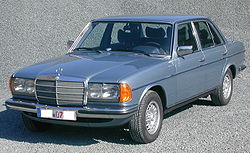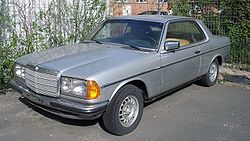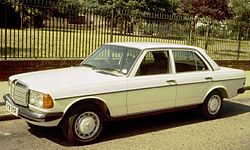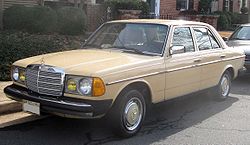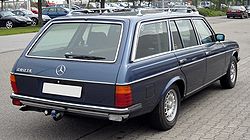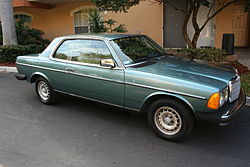- Mercedes-Benz W123
-
Mercedes-Benz W123 Manufacturer Daimler-Benz Production 1976–1986
2,696,915 built[1]
4-door: 2,397,514
Coupé: 99,884
Estate: 199,517Assembly Sindelfingen, Germany Predecessor Mercedes-Benz W115 Successor Mercedes-Benz W124 Class Executive car Body style(s) 4-door saloon
2-door coupé
5-door estate
4-door limousineEngine(s) 2.0 L I4
2.2 L I4 Diesel
2.3 L I4
2.4 L I4 Diesel
2.5 L I6
2.8 L I6
3.0 L I5 Diesel
2.0 L I4 DieselTransmission(s) 3-speed automatic
4-speed automatic
4-speed manual
5-speed manualWheelbase Sedan: 2,795 mm (110.0 in)
Coupé: 2,710 mm (106.7 in)Length Sedan: 4,724 mm (186.0 in)[2] (euro-spec bumpers) Width Sedan: 1,784 mm (70.2 in)[2] Height Sedan: 1,435 mm (56.5 in)[2] Curb weight Sedan: 2,080 kg (4,585.6 lb) (turbodiesel, automatic) Vehicles Mercedes-Benz E-Class W123 is the internal chassis-designation Mercedes-Benz used for their executive line of cars, manufactured between 1976 and 1985.
The W123 models surpassed their predecessor, the W114 and W115 models, as the most successful Mercedes, selling 2.7 million cars before replacement by the W124 after 1985. The additional range of smaller Mercedes-Benz W201 models were introduced in 1982.
Contents
Naming
As usual, model names were related to engine sizes, type of engine and chassis type:
- C for Coupé
- Lang (long-wheelbase)
- T for Transport and Touring (estate/station wagon)
- D for Diesel,
- E for Einspritzung (fuel injection)
Model history
Mercedes-Benz introduced the W123 four-door versions in January, 1976.[3] While there were some technical similarities to their predecessors, the new models were larger in wheelbase and exterior dimensions. The styling was also updated, although stylistic links with the W115 were maintained. Initially, all models except 280/280E featured quad unequal-size round headlights and the latter large rectangular units. When facelifted these units became standard across the range. All W115 engines were carried over, with the 3 litre 5-cylinder diesel model being renamed from "240D 3.0" to "300D" (as it had already been called before in North American markets). The only new engine was the 250's 2525 cc inline-six (Type M123, a short-stroke version of the 2.8 litre six Type M110) that replaced the old 2496 cc Type M114 six.
In the spring of 1976, a coupé version was introduced on a shorter wheelbase than the saloon (2,710 mm (106.7 in) versus 2,795 mm (110.0 in)) for the saloon. This W123C/CE was available as a 230C (later 230CE) and as a 280C/CE in most markets; in North America there were additional 300CD versions with naturally aspirated, later turbocharged 3 litre diesel engines.
It is a tribute to the car's instant popularity – and possibly to the caution built into the production schedules – that nine months after its introduction, a black market had developed in Germany for Mercedes-Benz W123s available for immediate delivery.[4] Customers willing to order new cars from their local authorized dealer for the recommended list price faced waiting times in excess of twelve months.[4] Models that were barely used and were available almost immediately commanded a premium over the new price of around DM 5,000.[4]
From August, 1977, long-wheelbase versions (3,425 mm (134.8 in)) were produced. These were available as 7/8 seater saloons with works bodies or as a chassis with complete front body clip, the latter serving as the base for ambulance and hearse bodies by external suppliers like Binz or Miesen. These "Lang" versions could be ordered as 240D, 300D and 250 models.
At the Frankfurt Auto Show in September, 1977 the W123T estate was introduced; the T in the model designation stood for "Touring and Transport". All engines derivative except "200TD" were available in the range. T production began in March, 1978 in Mercedes' Bremen factory.
In early 1979, the diesel models power output was increased; power rose from 55 PS (40 kW; 54 hp) to 60 PS (44 kW; 59 hp) in the 200D, from 65 PS (48 kW; 64 hp) to 72 PS (53 kW; 71 hp) in the 240D and from 80 PS (59 kW; 79 hp) to 88 PS (65 kW; 87 hp) in the 300D; at the same time, the 220D went out of production.
The first Mercedes turbo diesel production W123 appeared in September, 1979. This was the 300 TD Turbodiesel, available with automatic transmission only. In most markets, the turbocharged 5-cylinder 3 litre diesel engine (Type OM617) was offered only in the T body style, while in North America it was also available in saloon and coupé guises.
June 1980 saw the introduction of new 4-cylinder petrol engines (Type M102). A new 2 litre four with shorter stroke replaced the old M115, a fuel-injected 2.3 litre version of this engine (in 230E/TE/CE) the old carbureted 230. Both engines were more powerful than their predecessors.
In 1980/81 the carbureted 280 versions went out of production; the fuel-injected 280E continued to be offered.
In September, 1982, all models received a mild facelift. The rectangular headlights, previously fitted only to the 280/280E, were standardized across the board, as was power steering. Since February, 1982, an optional 5-speed manual transmission was available in all models (except 300 TD).
W123 production ended in January, 1986 with 63 T-models rolling out. Most popular single models were the 240D (455,000 built), the 230E (442,000 built) and the 200D (378,000 built).
W123 introduced innovations including ABS (optional from August, 1980), a retractable steering column and an airbag for the driver (optional from 1982).
Available options included MB-Tex (Mercedes-Benz Texturized Punctured Vinyl) upholstery or velour or leather upholstery, interior wood trim, passenger side exterior mirror (standard on T models), 5-speed manual transmission (European market only), 4-speed automatic transmission (standard in turbodiesel models), power windows with rear-seat switch cut-outs, vacuum powered central locking, rear-facing extra seats (station wagon only), Standheizung (prestart timer controlled engine heating), self locking differential, sun roof, air conditioning, climate control, "Alpine" horn (selectable quieter horn), headlamp wipers (European market only), Tempomat (cruise control), power steering (standard after 1982/08), seat heating, catalytic converter (available from 1984 for California only, from fall (autumn) 1984 also in Germany for the 230E of which one thousand were built).
Power (vacuum servo) assisted disc brakes were standard on all W123s.
Models (except North America and Japan)
Chassis code Years Model Engine Power Torque W123.020 1976–1981 200 2.0 L M115 I4 94 PS (69 kW; 93 hp) @ 4800 158 N·m (117 lb·ft) @ 3000 W123.220 1979–1985 200 2.0 L M102 I4 109 PS (80 kW; 108 hp) @ 5200 170 N·m (125 lb·ft) @ 3000 W123.280 1980–1985 200T 2.0 L M102 I4 109 PS (80 kW; 108 hp) @ 5200 170 N·m (125 lb·ft) @ 3000 W123.120 1976–1979 200D 2.0 L OM615 I4 Diesel 55 PS (40 kW; 54 hp) @ 4200 113 N·m (83 lb·ft) @ 2400 W123.120 1979–1985 200D 2.0 L OM615 I4 Diesel 60 PS (44 kW; 59 hp) @ 4400 113 N·m (83 lb·ft) @ 2400 W123.126 1976–1979 220D 2.2 L OM615 I4 Diesel 60 PS (44 kW; 59 hp) @ 4200 125 N·m (92 lb·ft) @ 2400 W123.023 1976–1981 230 2.3 L M115 I4 109 PS (80 kW; 108 hp) @ 4800 185 N·m (136 lb·ft) @ 3000 W123.223 1979–1985 230E 2.3 L M102 I4 136 PS (100 kW; 134 hp) @ 5100 201 N·m (148 lb·ft) @ 3500 W123.043 1977–1980 230C 2.3 L M115 I4 109 PS (80 kW; 108 hp) @ 4800 185 N·m (136 lb·ft) @ 3000 W123.243 1980–1985 230CE 2.3 L M102 I4 136 PS (100 kW; 134 hp) @ 5100 201 N·m (148 lb·ft) @ 3500 W123.083 1978–1980 230T 2.3 L M115 I4 109 PS (80 kW; 108 hp) @ 4800 185 N·m (136 lb·ft) @ 3000 W123.283 1980–1985 230TE 2.3 L M102 I4 136 PS (100 kW; 134 hp) @ 5100 201 N·m (148 lb·ft) @ 3500 W123.123 1976–1985 240D 2.4 L OM616 I4 Diesel 65 PS (48 kW; 64 hp) @ 4200
from 02/79 72 PS (53 kW; 71 hp) @ 4400137 N·m (101 lb·ft) @ 2400 W123.125 1977–1985 240D LWB 2.4 L OM616 I4 Diesel 65 PS (48 kW; 64 hp) @ 4200
from 02/79 72 PS (53 kW; 71 hp) @ 4400137 N·m (101 lb·ft) @ 2400 W123.183 1978–1986 240TD 2.4 L OM616 I4 Diesel 65 PS (48 kW; 64 hp) @ 4200
from 02/79 72 PS (53 kW; 71 hp) @ 4400137 N·m (101 lb·ft) @ 2400 W123.026 1976–1985 250 2.5 L M123 I6 129 PS (95 kW; 127 hp) @ 5500
from 09/79 140 PS (100 kW; 140 hp) @ 5500192 N·m (142 lb·ft) @ 3500
from 09/79 196 N·m (145 lb·ft) @ 3500W123.028 1977–1985 250 LWB 2.5 L M123 I6 129 PS (95 kW; 127 hp) @ 5500
from 09/79 140 PS (100 kW; 140 hp) @ 5500192 N·m (142 lb·ft) @ 3500
from 09/79 196 N·m (145 lb·ft) @ 3500W123.086 1978–1985 250 2.5 L M123 I6 140 PS (100 kW; 140 hp) @ 5500
from 09/79 140 PS (100 kW; 140 hp) @ 5500192 N·m (142 lb·ft) @ 3500
from 09/79 196 N·m (145 lb·ft) @ 3500W123.030 1975–1981 280 2.8 L M110 I6 156 PS (115 kW; 154 hp) @ 5500 222 N·m (164 lb·ft) @ 4000 W123.033 1975–1985 280E 2.8 L M110 I6 177 PS (130 kW; 175 hp) @ 6000
from 1978 185 PS (136 kW; 182 hp) @ 5800229 N·m (169 lb·ft) @ 4500
from 09/79 235 N·m (173 lb·ft) @ 4500W123.050 1977–1980 280C 2.8 L M110 I6 156 PS (115 kW; 154 hp) @ 5500 222 N·m (164 lb·ft) @ 4000 W123.053 1977–1985 280CE 2.8 L M110 I6 177 PS (130 kW; 175 hp) @ 6000
from 1978 185 PS (136 kW; 182 hp) @ 5800229 N·m (169 lb·ft) @ 4500
from 09/79 235 N·m (173 lb·ft) @ 4500W123.093 1978–1985 280E 2.8 L M110 I6 185 PS (136 kW; 182 hp) @ 6000
from 1978 185 PS (136 kW; 182 hp) @ 5800229 N·m (169 lb·ft) @ 4500
from 09/79 235 N·m (173 lb·ft) @ 4500W123.130 1976–1985 300D 3.0 L OM617 I5 Diesel 80 PS (59 kW; 79 hp) @ 4000
from 09/79 88 PS (65 kW; 87 hp) @ 4400169 N·m (125 lb·ft) @ 2400 W123.132 1977–1985 300D LWB 3.0 L OM617 I5 Diesel 80 PS (59 kW; 79 hp) @ 4000
from 09/79 88 PS (65 kW; 87 hp) @ 4400169 N·m (125 lb·ft) @ 2400 W123.133 1981–1985 300D Turbo 3.0 L OM617a I5 Diesel 125 PS (92 kW; 123 hp) @ 4350 245 N·m (181 lb·ft) @ 2400 W123.150 1977–1981 300CD 3.0 L OM617 I5 Diesel 80 PS (59 kW; 79 hp) @ 4000
from 09/79 88 PS (65 kW; 87 hp) @ 4400169 N·m (125 lb·ft) @ 2400 W123.153 1981–1985 300CD Turbo 3.0 L OM617a I5 Diesel 125 PS (92 kW; 123 hp) @ 4350 245 N·m (181 lb·ft) @ 2400 W123.190 1978–1985 300TD 3.0 L OM617 I5 Diesel 80 PS (59 kW; 79 hp) @ 4000
from 09/79 88 PS (65 kW; 87 hp) @ 4400169 N·m (125 lb·ft) @ 2400 W123.193 1980–1985 300TD Turbo 3.0 L OM617a I5 Diesel 125 PS (92 kW; 123 hp) @ 4350 245 N·m (181 lb·ft) @ 2400 North America and Japan
In these markets the following models were offered...[5]:
Model Years Engine Power Torque 230 MY 1977–1978 M115 93.0 hp (69 kW) @ 4800 125 lb·ft (169 N·m) @ 2500 240D MY 1977–1983 OM616.912 62 hp (46 kW) @ 4000
from MY 1981 67 hp (50 kW) @ 400097 lb·ft (132 N·m) @ 2400 280E MY 1977–1981 M110 142 hp (106 kW) @ 5750
from MY 1980: 140 hp (104 kW) @ 5500149 lb·ft (202 N·m) @ 4600
from MY 1980: 145 lb·ft (197 N·m) @ 4600280CE MY 1978–1981 M110 142 hp (106 kW) @ 5750
from MY 1980: 140 hp (104 kW) @ 5500149 lb·ft (202 N·m) @ 4600
from MY 1980: 145 lb·ft (197 N·m) @ 4600300D MY 1977–1981 OM617.912 77 hp (57 kW) @ 4000
from MY 1981: 83 hp (62 kW) @ 4200115 lb·ft (156 N·m) @ 2400
from MY 1981: 120 lb·ft (163 N·m) @ 2400300CD MY 1978–1981 OM617.912 77 hp (57 kW) @ 4000
from MY 1981: 83 hp (62 kW) @ 4200115 lb·ft (156 N·m) @ 2400
from MY 1981: 120 lb·ft (163 N·m) @ 2400300TD MY 1979–1980 OM617.912 77 hp (57 kW) @ 4000 115 lb·ft (156 N·m) @ 2400 300TD Turbo MY 1981–1985 OM617.952 125 hp (93 kW) @ 4350 181 lb·ft (245 N·m) @ 2400 300D MY 1981–1985 OM617.952 125 hp (93 kW) @ 4350 181 lb·ft (245 N·m) @ 2400 300CD MY 1981–1985 OM617.952 125 hp (93 kW) @ 4350 181 lb·ft (245 N·m) @ 2400 The North American W123s differ from the European W123s due to United States Department of Transportation requirements.
Notable exterior differences included:
- Larger bumpers
- Round, sealed-beam headlights/fog lamps. Early cars were delivered with clear fog lamps through to model year 1979, later units with yellow
- Location of ID-tag on A-pillar
- Emission control devices
References
- ^ Oswald, Werner (2001). Deutsche Autos 1945–1990, vol.3. Stuttgart: Motorbuch Verlag. p. 99. ISBN 3-613-02131-5.
- ^ a b c "Autotest: Mercedes-Benz 200". Autocar 149 (nbr 4271): Pages 26–31. 16 September 1978.
- ^ All dates in this paragraph according to: Oswald, Werner (2001). Deutsche Autos 1945–1990, vol.3. Stuttgart: Motorbuch Verlag. pp. 96–111. ISBN 3-613-02131-5.
- ^ a b c "Sterntaler: Mercedes-Wagen zu Schwarzmarktpreisen". Auto Motor u. Sport Heft 18 1976: Seite 8–9. date 1 September 1976.
- ^ Mike Covello: Standard Catalog of Imported Cars 1946–2002. Krause Publications, Iola 2002, ISBN 0-87341-605-8, p. 539-43.
External links
Categories:- Mercedes-Benz model codes
- Mercedes-Benz vehicles
- Executive cars
- Vehicles introduced in 1976
Wikimedia Foundation. 2010.

